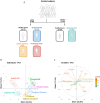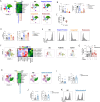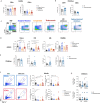Impairment of Innate Immunity and Depletion of Vaccine-Induced Memory B and T Cells in the Absence of the Spleen
- PMID: 39953916
- PMCID: PMC11966361
- DOI: 10.1002/ajh.27634
Impairment of Innate Immunity and Depletion of Vaccine-Induced Memory B and T Cells in the Absence of the Spleen
Abstract
Splenectomy or congenital asplenia is associated with severe reduction of memory B cells and increased risk of fulminant sepsis by encapsulated bacteria. Current guidelines recommend vaccinations against these pathogens before or after splenectomy, but the longevity of immunity acquired after splenectomy has not been determined. The impact of splenectomy on innate immune cells is unknown. We analyzed frequency, differentiation stage, and function of innate and adaptive immunity in the peripheral blood of adult (n = 41) and pediatric (n = 14) patients splenectomized or born asplenic and in spleens of solid organ donors. The absence of the spleen impacts the B-cell compartment, causing a significant increase of circulating immature transitional and depletion of memory B cells. Using SARS-CoV-2 vaccination as a model, we show that 1 year after the last immunization, despite normal levels of neutralizing antibodies, memory B and T cells were significantly reduced. Analysis of post-pandemic spleens shows that spike-specific memory B and T cells homed to the spleen. We also show a previously unrecognized role of the spleen in the homeostasis of innate NK and Vδ2 T cells. These populations showed altered phenotype and impaired function in the adults, but not in children, suggesting that other tissues may support innate cell development during early life. The reduced function of innate lymphocytes must be considered as an additional immune impairment and risk factor. These findings emphasize the spleen's irreplaceable role in maintaining immune memory across all ages and suggest that its absence contributes to dysfunctions of innate and adaptive immunity in adults.
Keywords: Asplenia; Immune Memory; Innate immunity.
© 2025 The Author(s). American Journal of Hematology published by Wiley Periodicals LLC.
Conflict of interest statement
The authors declare no conflicts of interest.
Figures






References
-
- Di Sabatino A., Carsetti R., and Corazza G. R., “Post‐Splenectomy and Hyposplenic States,” Lancet 378, no. 9785 (2011): 86–97. - PubMed
-
- cdc , “General Best Practice Guidelines for Immunization,” accessed August 1, 2023, www.cdc.gov/vaccines/hcp/acip‐recs/general‐recs/immunocompetence.htm.
-
- Davies J. M., Lewis M. P. N., Wimperis J., Rafi I., Ladhani S., and Bolton‐Maggs P. H. B., “Review of Guidelines for the Prevention and Treatment of Infection in Patients With an Absent or Dysfunctional Spleen: Prepared on Behalf of the British Committee for Standards in Haematology by a Working Party of the Haemato‐Oncology Task Force,” British Journal of Haematology 155, no. 3 (2011): 308–317. - PubMed
-
- Lenti M. V., Luu S., and Carsetti R., “Asplenia and Spleen Hypofunction,” Nature Reviews. Disease Primers 8 (2022): 71. - PubMed
MeSH terms
Substances
Grants and funding
LinkOut - more resources
Full Text Sources
Medical
Miscellaneous

